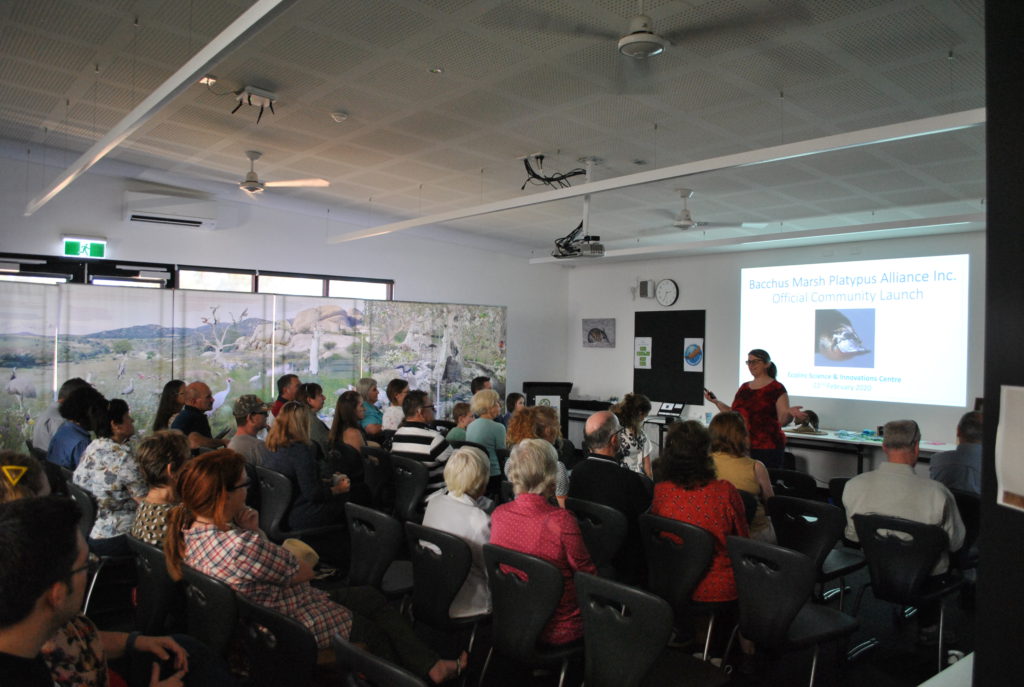When the Werribee River in Bacchus Marsh turned orange from sediment in late 2018, some local community members began to ask, “Is Patrick the Platypus OK”? Patrick is the name locals had given to the platypus (or platypuses) living in that section of the river. We were worried this severe level of sediment would smother “Patrick’s” food supply – invertebrates. Platypus cannot survive where their food has been killed. The river stayed orange for eight months! Action was needed.
In response, a small group of local residents came together to form the Bacchus Marsh Platypus Alliance. The Australian Citizen Science Association (ASCA) seed grant came at just the right time for the newly formed Alliance. It provided us with vital equipment and resources to get our citizen science activities started, and has done just what a seed should – germinated into projects that are ongoing and will continue to grow.
With the help of some professionals we had already traced the sediment back to new housing developments. And we had noticed another new threat coming into the river – construction litter. We had also discovered that “Patrick” wasn’t recorded on official databases – there were videos of him/her on Facebook, but these hadn’t translated into database entries. We realised we’d need community help to monitor river health and platypus!

In February 2020 we held a community launch of the Bacchus Marsh Platypus Alliance, which was attended by over 90 community members (thankfully held before COVID-19 took hold in Victoria). The ASCA seed funding allowed us to survey community members about knowledge of river health and platypus before and after the launch, and these surveys will continue as our citizen science activities progress. The launch included children’s activities, guest speakers on monitoring platypus, and a “platypus habitat” walk and talk along the river. Many survey respondents said they didn’t even know we had platypus in Bacchus Marsh until the event was advertised! The launch helped us recruit further volunteers.


The ASCA seed funding also allowed me to attend a workshop on community engagement and behaviour change – the latter being relevant to ways we could use data collected to help change behaviours that were causing construction sediment and litter to enter the river. Melbourne Water’s Waterwatch and Werribee River Association helped us set up litter auditing by citizen scientists in key locations, and the training helped translate the data collected into real action. We held a “Please Protect Our Platypus” poster competition for children in collaboration with Waterwatch and Werribee River Association. Some of the poster artwork is now being turned into “Clean Site for Platypus” signs for local construction sites. Our local Council has also used data collected by the citizen scientists, to inform Council action on the issues.

In addition, some of the ASCA seed funding was put towards the purchase of water monitoring equipment, so we could sample water turbidity (an indicator of sedimentation) as needed, and train additional citizen scientists to do so. This has been immensely helpful, although our training plans were interrupted by the COVID-19 situation. Likewise, face-to-face citizen scientist training for platypus monitoring had to be put on hold, but we’re looking forward to this resuming soon.
There have been two key challenges throughout the above. The first, as mentioned, has been COVID-19, which has forced us to adapt some of our plans and has certainly tested our flexibility. Despite this, we’ve been able to build and maintain community connections, and progress some of our projects. We have lots of citizen science volunteers keen to get back out there together ‘in the field’ once the situation allows. The other has been a blow from left field – a local company tendering to place 1.5 million cubic metres of PFAS-contaminated spoil (from a large infrastructure project) right next to a waterway that feeds into Werribee River. This again places our platypus at risk, as well as the endangered Growling Grass Frogs that inhabit the tributary waterway. This new issue has required a mammoth amount of our time. However, it has also rallied the local community to appreciate our precious waterways and fauna even more, and become more involved in their protection.
One key thing I’ve learnt and valued throughout this journey is how little steps can grow into bigger steps when connections with others are made. Without this seed funding we would not have been able to take these initial steps. They provided a solid foundation, which allowed us to then obtain further skills and top-up funding to grow this project even further. The community response and support has been amazing, and continues to expand.
It is now platypus breeding season once again. We hope Patrick or perhaps Patricia the Platypus will still call Bacchus Marsh home. This time there will be citizen scientists at the ready to ensure they are better valued and protected!

This is a great step forward and shows what can be done with a few people working together toward change.
Thank you for the article, it has inspired me to take a closer look at our platypus lifestyle here in Sth Gippsland
thank you for making this article very useful and keep up the good work